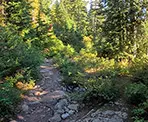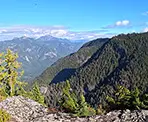- Difficulty Intermediate
- Time 3 hours
- Round-Trip 5km
- Elevation Gain 140 meters
- Season July - October
- Camping No
- From Vancouver 50 minutes
- Public Transit No
- Dog Friendly No
Suicide Bluffs is located in Mount Seymour Provincial Park in North Vancouver and has several scenic views that look towards the city of Vancouver. The trail has some steep ups and downs and is technical in places with some rope assists making it more difficult compared to other nearby hiking trails.
Starting from the Mount Seymour parking lot, walk to the far end of the parking lot where the big wooden map board is and go right, walking down the short hill towards the ski lift. Walk towards the treeline on the left and follow the rocky Mount Seymour Trail that goes uphill and is parallel to the ski run (do not take the trail to Dog Mountain).
Continue walking up the rocky hill, watching your step and pass the junction to Dinkey Peak. Continue past a second junction a short distance further and stay on the main trail, heading uphill. When you reach the 3rd junction where there is a clearing to the left, walk towards that clearing and looking for orange markers on the trees. If you ended up on a wide ski run, you missed the junction and you just have to walk back down the hill to the last junction.
Follow the trail and watch for the orange markers. The trail follows a ridgeline and has several ups and downs but make sure to stay on the trail as some of the sections just off the trail are extremely steep and dangerous.
The trail eventually reaches a rocky section, where you climb up and onto the rocky bluff and a large open clearing. From here, you can make your way to the far side where you can see great views of the city of Vancouver and the mountains to the northwest. This is Suicide Bluffs.
This is a great spot to end your hike, however if you want another view, you can continue to a rocky bluff further along the trail, however the next section of the trail is difficult and very technical. To continue, walk down the trail on the far west side of the rocky bluff, following the oranger markers on trees into the forest. The trail quickly descends and, at one point, requires a rope assist down a very tricky section of trail. After the rope, pass through the switch backs until you reach a small pond at the bottom. Then, the trail begins to ascend and you make your way up onto a rocky outcrop for a great view of the city.
The Suicide Bluffs continues beyond this point to a junction along the Dog Mountain Trail but it is not traveled a lot. This trail description suggests you return the same way you arrived by walking back downhill and up the steep hill with the rope assist to the bluff. Then, follow the trail eastward along the narrow route until it rejoins the Mount Seymour Trail, Follow the Mount Seymour Trail back down to the parking lot area.
How to get to Suicide Bluffs
Estimated Driving Time from Vancouver
50 minutes
The trail to Suicide Bluffs beings from the parking lot area of Mount Seymour Provincial Park in North Vancouver.
To drive to Mount Seymour from downtown Vancouver, drive east through the city, making your way to Highway #1. Enter the highway heading Northbound and drive across the Iron Workers Memorial Bridge (Second Narrows). Take Exit 22B to Mount Seymour Parkway as you stay to the right as you exit. Turn right at the lights onto Mount Seymour Parkway.
Follow Mount Seymour Parkway for 4.5km until you reach the lights at Mount Seymour Road. Turn left onto Mount Seymour Road and follow the road, staying to the left at the fork. Follow Mount Seymour Road to the top and park at the far end of the parking lot as close to the wooden map board as possible.
View a map of Driving directions to Suicide Bluffs.

Although we try to keep information as current as possible, www.vancouvertrails.com makes no warranty or representation as to the availability, quality, fitness for purpose, conditions or accuracy of the information provided with respect to this trail or trails. The information provided herein is further subject to our Terms of Use.







Comments
Add Comment View All Comments